Meet Kathi Macias
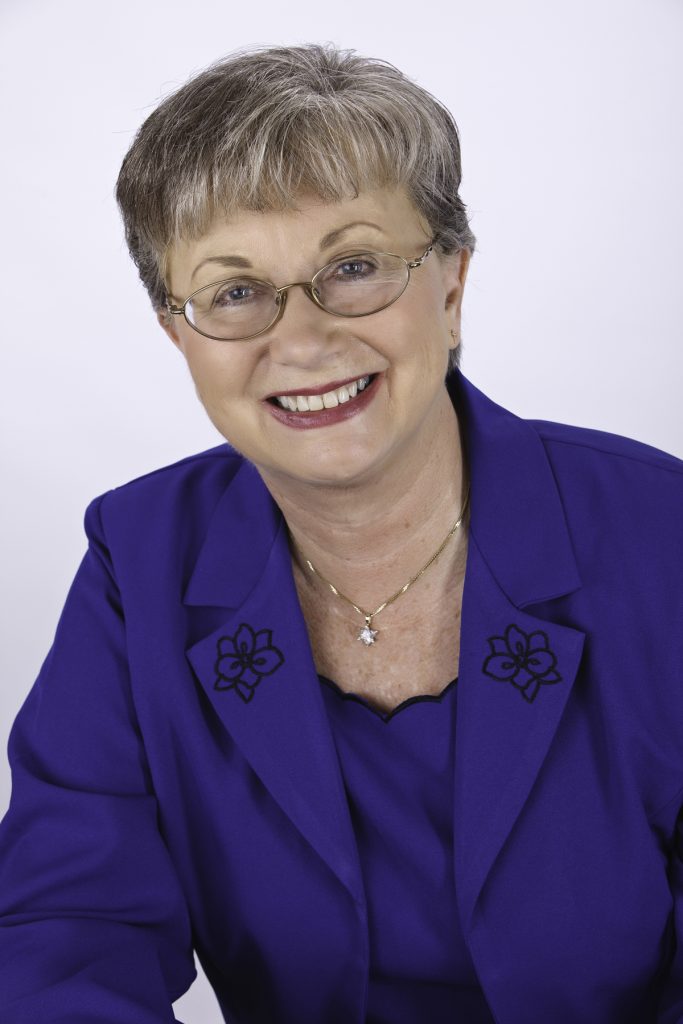
 Kathi Macias is an award-winning author of more than 50 books, including Golden Scrolls 2011 Novel of the Year, Red Ink. A wife, mother, grandmother, and great-grandmother, as well as a popular Bible teacher and conference speaker, Kathi lives in Southern California with her husband, Al.
Kathi Macias is an award-winning author of more than 50 books, including Golden Scrolls 2011 Novel of the Year, Red Ink. A wife, mother, grandmother, and great-grandmother, as well as a popular Bible teacher and conference speaker, Kathi lives in Southern California with her husband, Al.
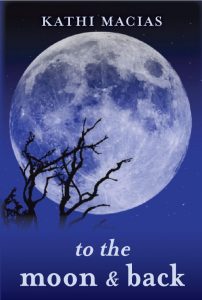 Tell us about your newest book.
Tell us about your newest book.
To the Moon and Back is a journey through the heartache of Alzheimer’s, told primarily from the viewpoint of a woman in the early- to mid-stages of the disease. It is also a story of her husband’s and grown daughter’s part in the journey.
What genre do you focus on and why?
It is a contemporary novel. I wanted to tell it through the medium of fiction, as it can then become “everyone’s story.” And, of course, it is contemporary because Alzheimer’s has only recently become widely recognized and discussed. Contemporary fiction, usually centered around a current “hot-button”/social issue topic, is my primary writing genre because they are topics I care about deeply.
Why do you write? What drives you?
I have loved to read/write since I was a child and have never wanted to be anything but a writer. Marrying my love of writing to my passion for social issues gives me every incentive I need to continue producing this sort of book.
Who is your main character, and how did you choose that name?
Rachel is my main character. It is a name I have always loved, and it seemed to fit my main character.
What does a day in your writing world look like?
No two are ever the same. With a retired husband, I need to stay flexible. For that reason, I now write only part-time (as opposed to the full-time I used to write before he retired). Because I am also active in my church, I try to limit my writing hours to about 20 a week, spaced out as best that particular week dictates/allows.
What is the hardest part of being an author? Why?
There’s an old saying, that “Writing is simple; you just sit down at your computer and open a vein.” There’s a lot of truth in that. Writing is a difficult and lonely profession, and the biggest challenge is to make yourself sit down and do it.
What’s the best part of your author’s life? Why?
The best part for me is being able to do what I love (writing) and, in the process, hopefully change lives for the better.
What is the craziest thing you’ve experienced as an author?
Writing two books with Rosey Grier as my co-author was both challenging and fun. At times he would introduce me as his “body guard” (if you can imagine the disparity in our sizes, you’ve got to know how hilarious that is), and some people actually believed it.
What are you most proud of?
I was at a book signing for my newest release, No Greater Love (set in South Africa in 1989), when a young man (high school age) came in and told me his mom had urged him to read that particular book. He did, and he said he wanted to tell me how much the book had impacted him. “It made me want to lead a more noble life,” he said. I will forever carry those words in my heart.
What is your favorite pastime?
Reading or traveling with my husband. And, of course, spending time with our grown children, our grandchildren, and even our great-grandchildren.
Do you have other books? We’d love to know.
I have more than 50 other books, many of which are featured on my website (www.kathimacias.com). Most are fiction, but there are a few nonfiction as well.
What are you working on now?
I’m in the early stages of deciding between writing a nonfiction Bible-study-type book or a humorous novel about life in a retirement community (loosely based on where my husband and I now live).
Website: www.kathimacias.com
Social media links: Facebook: Kathi Macias and Kathi Macias Author; Twitter: @alandkathi
Meet Melanie Dobson

 Writing fiction is Melanie Dobson’s excuse to explore abandoned houses, travel to unique places, and spend hours reading old books and journals. She enjoys weaving together time-slip stories, and her novels have won awards for historical romance, romantic suspense, and historical fiction. Melanie and her family live in the Pacific Northwest.
Writing fiction is Melanie Dobson’s excuse to explore abandoned houses, travel to unique places, and spend hours reading old books and journals. She enjoys weaving together time-slip stories, and her novels have won awards for historical romance, romantic suspense, and historical fiction. Melanie and her family live in the Pacific Northwest.
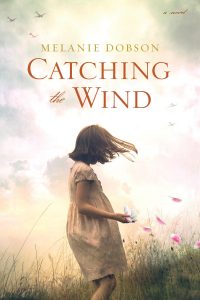 Tell us about Catching the Wind.
Tell us about Catching the Wind.
Several years ago, as I sat down to brainstorm a new novel, I looked out the window in my favorite coffee shop at a marvelous old tree with its sturdy branches and dangling leaves that ballooned like a giant umbrella over the people drinking coffee and tea below. In my mind’s eye, I saw two German children—the best of friends—playing high among those branches. In a tree house. They were in danger though at the time I didn’t know what threatened them. I just knew the boy and girl had to run. And the girl would be lost along the way.
As I sipped on my tea, the story of Dietmar and Brigitte began unfolding, coming alive on my computer screen. The rest of Catching the Wind is about what happened to these friends after they ran away, and Dietmar’s seventy-year search to find his friend.
What genre do you focus on and why?
I’ve written romantic suspense, historical romance, general historical, mystery, and contemporary fiction. I’ve enjoyed all of these genres and am, in a sense, combining them now as I weave together historical and contemporary plots in my time-slip novels.
Why do you write? What drives you?
I’ve enjoyed dreaming up story ideas and keeping a journal since I was a child. When I was nine, I typed out my “autobiography” (it was only a few paragraphs) and eventually went to college for journalism. After a few years working in public relations and writing newspaper articles, I felt as if God was prompting me to pursue my dream of writing fiction. It took seven years—and multiple manuscripts—before my first novel was published. Each time I think about returning to public relations now, another idea sparks in my heart and mind and I begin writing another story….
Who is your main character, and how did you choose that name?
The main character in my contemporary plot is Quenby Vaughn. I have a friend whose sister-in-law is named Quenby, and the first time I heard her name, I knew I wanted to use it for a character. In the past story, my male protagonist’s name changes from Dietmar Roth to Daniel Knight. This was very intentional, but I’d give away the storyline if I told you why.
What does a day in your writing world look like?
It depends on where I am in the process, but usually I’m at the coffee shop writing chapters, creating new characters, and editing my draft. I start my morning by editing my previous day’s work and then add about 2,000 more words to the manuscript. My favorite days are the ones when I’m immersed in mounds of research books or exploring a new setting as I dream about my next story.
What is the hardest part of being an author? Why?
Receiving harsh reviews is no fun, especially after I’ve poured myself into researching and writing a novel. And some days, editing is really hard for me. I can be rather averse to change.
What’s the best part of your author’s life? Why?
I enjoy creating stories and learning new things. I’m very grateful for the opportunity to do both of these things as a writer.
What are you most proud of?
My daughters, Karlyn and Kiki. As of this summer, they are both teenagers, and it’s such a treat to watch them grow in their faith and confidence and love of story.
What is your favorite pastime?
My imagination is fueled by exploring ghost towns, abandoned houses, old chapels, and forgotten cemetery. My family thinks I’m weird, but the wondering about those who once lived and/or were buried in these places inspires me.
Do you have other books? We’d love to know.
Thanks for asking! I’ve written about twenty novels now—some of my most recent ones are Chateau of Secrets, Enchanted Isle, and Shadows of Ladenbrooke Manor. Readers can find a complete list of my books here: http://melaniedobson.com/books/
What are you working on now?
I’m writing a time-slip novel about treasure that was hidden in Austria’s lake country during World War II. In the contemporary story, my protagonist discovers a list in an old book that connects her with an Austrian woman who lived during the war, and she determines to find out what happened long ago.
Website: www.melaniedobson.com
Link to book: https://www.amazon.com/Catching-Wind-Melanie-Dobson/dp/1496417283/ref=tmm_pap_swatch_0?_encoding=UTF8&qid=&sr=
Social media links: www.facebook.com/MelanieDobsonFiction and @MelBDobson
Meet Ann-Margret Hovsepian
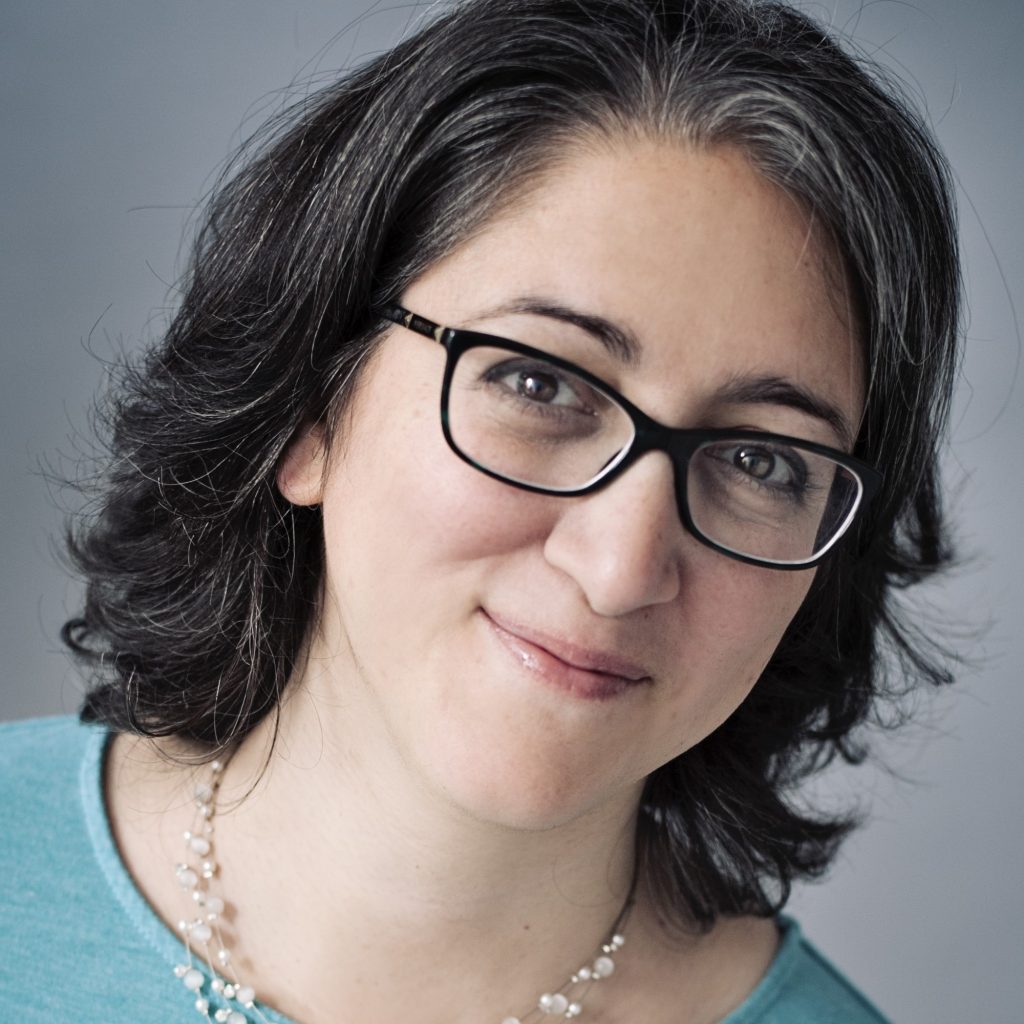
 Ann-Margret Hovsepian is a freelance writer and illustrator in Montreal, Canada, and the author of several books. She specializes in devotional and coloring books but has written on a broad range of topics for dozens of periodicals over the last 25 years.
Ann-Margret Hovsepian is a freelance writer and illustrator in Montreal, Canada, and the author of several books. She specializes in devotional and coloring books but has written on a broad range of topics for dozens of periodicals over the last 25 years.
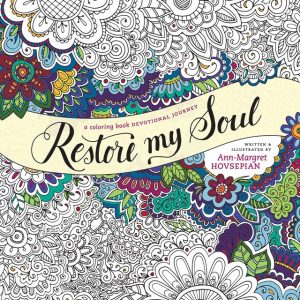 Tell us about your newest book.
Tell us about your newest book.
Scheduled for release in early October is Inkspirations for Breast Cancer Survivors, a coloring book featuring 32 original illustrations by me. My latest written book is Restore My Soul, which has 40 devotions, each with an accompanying coloring page I drew.
What genre do you focus on and why?
Everything I write is non-fiction, although I’m a big fan of reading fiction. I love to share real-life stories about exciting things people are doing all over the world as well as inspire people through my own experiences and life lessons.
Why do you write? What drives you?
I’ve always struggled a little bit with calling myself a writer because, unlike many writers, I see writing as something I do, not who I am. I write because I want to share good news with people and that’s one of the tools I’m skilled at using. For me, writing is the means to an end, not the end itself.
What does a day in your writing world look like?
Because I also illustrate and work on smaller freelance projects on an unpredictable schedule, I don’t have a typical writing day. I’m also quite involved in my church, in a women’s ministry and with other projects so one day, week or month never looks quite like another.
What is the hardest part of being an author? Why?
Wondering how much of an impact your book has on those who picked up a copy, and whether you should keep doing what you do.
What’s the best part of your author’s life? Why?
The flip side of my previous answer: hearing from people (especially young girls) who have been blessed by my books. It reminds me that God does a lot of work behind the scenes that I have no clue about.
What is the craziest thing you’ve experienced as an author?
This isn’t crazy as much as it is cool: The same day I picked up a copy of Lettie Cowman’s famous Streams in the Desert devotional book, I received an email from her great-great-niece saying she had a copy of one of my devotionals for preteen girls and loved it. That blew me away!
What are you most proud of?
Launching my freelance business at the age of 24 with no university education or formal training, just four years of experience working at trade magazine, and sticking to it these past 21 years. I love that I can now teach others about writing and freelancing.
What is your favorite pastime?
Anything creative: drawing, sewing, calligraphy, cooking, gardening, decorating. I love to make things come to life with my hands.
Do you have other books? We’d love to know.
Besides my two coloring books, I have three devotional books for preteen girls.
What are you working on now?
I am currently working on a couple of freelance projects and trying to flesh out ideas for a few more books.
Website: www.annhovsepian.com
Link to book: https://www.amazon.com/dp/1496414063/
Social media links: https://www.facebook.com/ann.hovsepian.author/, https://www.instagram.com/annhovsepian/
Meet Angela Breidenbach
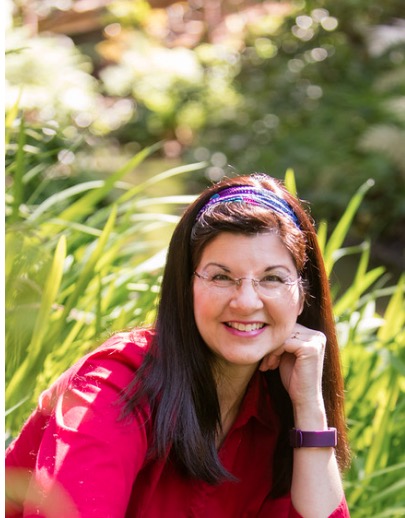
 Angela Breidenbach is a best-selling author of romance through the ages and host of Lit Up Talk Radio. She’s been writing prayers for writers for over three years as the Weekly Prayer Warrior of the Romance Writers of America/Faith, Hope, and Love Chapter. Angela is the Christian Author Network’s president. And yes, she’s half of the fun fe-lion comedy duo, Muse and Writer. Always family-friendly — Always good for your heart.
Angela Breidenbach is a best-selling author of romance through the ages and host of Lit Up Talk Radio. She’s been writing prayers for writers for over three years as the Weekly Prayer Warrior of the Romance Writers of America/Faith, Hope, and Love Chapter. Angela is the Christian Author Network’s president. And yes, she’s half of the fun fe-lion comedy duo, Muse and Writer. Always family-friendly — Always good for your heart.
Tell us about your newest book.
Worthy to Write! Blank page tying your stomach in knots? 30 prayers to tackle that fear!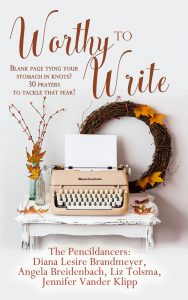
Worthy to Write! The book that tackles those fears that holds you back from putting words on the page and submitting your work as a professional. Fears like—I can’t let anyone read my stories. Who cares about what I have to say? Who would read anything I wrote anyway? I’m not special or original enough. Do those fears fly through your mind like a plague of locusts, eating up your confidence each time you sit down to write? All those fears, and more, boil down to one problem—feeling unworthy. But you are worthy! God gave you a voice and all those ideas swirling in your head for a reason: to write them so that you can make a difference in the world.
Presented by the Pencildancers: Angela Breidenbach, Diana Lesire Brandmeyer, Liz Tolsma, and Jennifer Vander Klipp because we’ve also experienced those fears and worked through them to become best-selling, award-winning authors. We want that for you, too! First in the new Worthy series, Worthy to Write is written for the author on the journey to use God-given talent for His glory!
What genre do you focus on and why?
I actually enjoy writing in several genres including historical and contemporary romance, non-fiction inspirational (devotions and life enhancement which is often called Christian Living in bookstores and libraries), cat comedy, and educational that includes genealogy and technology. I love sharing what I learn in both story form and to help others grow personally. I also like to make people smile with silly or poignant cat comedy social media posts.
Who is your main character?
In this case, the main character is You, the Writer. In Worthy to Write, the four authors came together to help other writers overcome the fears we’d all experienced…and often still do. We felt called to lift up others in order to encourage talented writers to express themselves the way God meant them to and do it in spite of fear. So you, dear hopeful writer, are the main character of this book.
What does a day in your writing world look like?
Do I dare admit it has way too much email time??? Because I volunteer as the president of the Christian Authors Network, I spend a lot of time on email helping manage the organization and helping other writers learn more about technology. I’m also in college for genealogy. So that means my writing time is a lot less than it was in the past few years. I also write a lot of journalistic articles and/or blog posts for larger websites. Since this year started getting crammed I decided to learn how to dictate my books. I’m on a learning curve and discovering how this all might work for me with 1-2 hours of dictation time that rotates with editing that dictation. And a lot of late night college reading…
What is the hardest part of being an author? Why?
I think the hardest part of being an author right now is the crazy rate of speed that things keep changing in the industry. There’s no comfort zone—ever! There’s a constant deluge of learning a new social media platform or figuring out how the new algorithm works or learning a new way to format for a new sales platform… Oh, and don’t forget the amount of new programs and tech and the costs of all of those things… I think you get the picture. It used to be whether a writer could learn to type and then switch to a computer, but then those authors had a tough time finding ways to reach their readers. This new age of technology allows us to reach out in new ways.
What’s the best part of your author’s life? Why?
Getting to be me. When I worked for employers I had to meet their goals. Being an author and radio host, I get to meet my own goals. That’s incredibly freeing both emotionally and physically. I don’t have to work 8-5 p.m. I love setting my own based on the time of day I do the best work for that particular kind of work. So I tend to do radio and business items between 10 a.m. and 2 p.m. Then I enjoy getting creative later in the day. I’ve often found myself working late into the night completely unaware of passing time.
What is the craziest thing you’ve experienced as an author?
The shock that people think I’m funny with cat comedy! I posted a photo of Muse shortly after he came home from the local pound. (I believe in pet rescue.) I’d posted a short, silly conversation between Writer and Muse. It took off in a way I never expected. Now I’m working on a calendar, gift book, and other ideas. This is one arena—that Muse and Writer are continuing to gain readers—still shocks me four years later! But the private notes I get from readers, that the humorous conversations help them, telling me how, really drives me to figure out this opportunity to share Muse’s amusing quips. This is the hardest learning curve for me because there’s a lot of techie hurdles with photography and publishing software that I have to leap. I did not see cat comedy coming! I certainly had no idea it would be a constant in my writing life. But it’s so much fun!
What are you most proud of?
Taking the chance on my dreams. I changed from standard business, chasing someone else’s dream for them, to this crazy business of public creativity. I was terrified. I went through a lot of challenges. Challenges happen in every stage. But, I thank God for being there with me through it all and giving me the courage to leap.
What is your favorite pastime? Right now, and it changes, I really love my college classes in English/Scottish genealogical studies. The classes are fascinating and often lead me off on wild tangents of curiosity.
Do you have other books? We’d love to know.
Yes, thanks for asking. I’m working on book #17. But here are a few current titles:
Historical Romance
The Captive Brides Collection
Second Chance Brides Collection
The Debutante Queen (1st in the Montana Beginnings series)
Non-Fiction
Gems of Wisdom: The Treasure of Experience
Contemporary Romance:
Out of Their Element (releasing Feb. 1st, 2018 with authors Robin Lee Hatcher, Vickie McDonough, and Deborah Raney). Full length novels exploring four couples that find romance in totally unexpected ways.
What are you working on now?
We have another “Worthy” devotion in the works for this series.
Website: http://www.AngelaBreidenbach.com
Book Link (avail Kindle or Paperback): http://amzn.to/2gFTe1c
Social media links:
https://Toginet.com/shows/litup/
Facebook/Twitter/Pinterest/Instagram: @AngBreidenbach
Meet Jen Turano
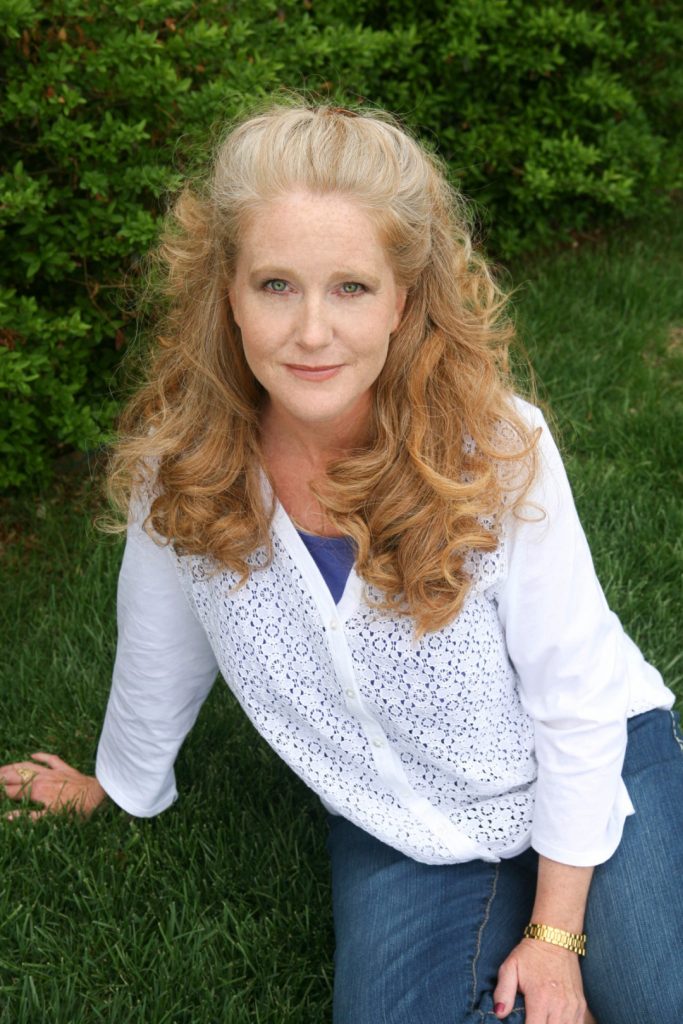
 Jen Turano is a USA Today Best-Selling Author, known for penning quirky historical romances set in the Gilded Age. She’s been a finalist twice for the RT Reviewers’ Choice Awards, had two of her books named top ten romances from Booklist, and was named One of the Funniest Voices in Inspirational Romance by Booklist. When she’s not writing, she spends her time outside Denver, CO.
Jen Turano is a USA Today Best-Selling Author, known for penning quirky historical romances set in the Gilded Age. She’s been a finalist twice for the RT Reviewers’ Choice Awards, had two of her books named top ten romances from Booklist, and was named One of the Funniest Voices in Inspirational Romance by Booklist. When she’s not writing, she spends her time outside Denver, CO.
Tell us about your newest book.
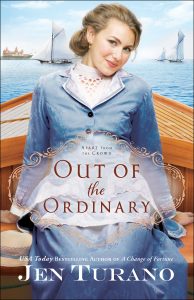 Out of the Ordinary, released yesterday and is the second book in the Apart from the Crowd series.
Out of the Ordinary, released yesterday and is the second book in the Apart from the Crowd series.
Miss Gertrude Cadwalader hoped her position as the paid companion to Mrs. Davenport would be easy. But as she becomes acquainted with her employer, she realizes the wealthy Mrs. Davenport has a strange tendency to be a bit light-fingered with other people’s trinkets. Gertrude is relieved when Mrs. Davenport decides to have a quiet summer away from the social scene—until the woman changes her mind in order to help a young socialite launch into society.
When Gertrude is caught in the act of trying to return one of the trinkets by Mrs. Sinclair, the mother of shipping magnate Harrison Sinclair, the woman jumps to an unfortunate conclusion. Harrison is determined to mend fences with Miss Cadwalader, but he’s unprepared for the escapades a friendship with her will entail.
What genre do you focus on and why?
I write historical romance set in the Gilded Age, having fallen in love with that time period after reading about Alva Vanderbilt’s famed costume ball of 1883. I’ve always been drawn to high society, and the New York Four-Hundred as it was called was filled with so many outlandish members that I have enough fodder for stories for years to come.
Why do you write? What drives you?
I’ve always had stories in my head and I’ve always had a knack for the written word—it just took me a long time to figure that out. As for what drives me—deadlines drive me these days. As long as I keep my writing steady, I can normally avoid chaos, but I have to maintain a pretty strict writing schedule in order to keep my sanity.
Who is your main character, and how did you choose that name?
Miss Gertrude Cadwallader is my heroine. I found her name in a book about the New York Four-Hundred and knew I just had to have her in a story.
What does a day in your writing world look like?
I’m normally at my computer around 7:30. I take a five-mile walk before that, which seems to get me settled for the day. And then I work until I meet my word-count or chapter goal—which means I do about a chapter and a half a day—sometimes more, sometimes less. When I’m doing a content edit—that’s what I get after I’ve turned in the story and my editors go through it and make…suggestions, my days are a little different and are usually a lot longer. Last week I worked one day from 6:00 am until after midnight because I was on a roll and didn’t want to lose that momentum.
What is the hardest part of being an author? Why?
First drafts—facing those pesky blank pages is a little daunting day after day.
What’s the best part of your author’s life? Why?
The readers—I never even thought about how many people I’d come to know by being an author. But I’ve made wonderful friends with so many readers, and that’s just been the coolest thing ever.
What are you most proud of?
My son.
What is your favorite pastime?
Al (husband) and I love to socialize with our friends.
Do you have other books? We’d love to know.
I do have other books, thank you for asking. From earliest release date to latest –
First Series – Ladies of Distinction – In order
(Gentleman of Her Dreams – e-book only – free novella)
A Change of Fortune – book one
A Most Peculiar Circumstance – book two
A Talent for Trouble – book three
A Match of Wits – book four
Series Two – A Class of Their Own
After a Fashion – book one
In Good Company – book two
Playing the Part – book three
Series Three – Apart from the Crowd
(At Your Request – e-book only – novella – free download)
Behind the Scenes –book one
Out of the Ordinary – book two – releases November 7, 2017
Caught by Surprise – book three – releases late spring 2018
What are you working on now?
I just turned in the content edits for Caught by Surprise, so I’ll be returning to a first draft of my next series come Monday. That series is sort of an American Heiress gone rogue thing—the first book is Miss Isadora Delafield’s story—and the story concept came about with a What If —What if Consuelo Vanderbilt flatly refused to marry the Duke of Marlborough even though her mother was threatening her with dire consequences if she didn’t marry the man—we’ll see how it goes.
Website: www.jenturano.com
Link to book: http://bakerpublishinggroup.com/authors/jen-turano/1761
Social media links: https://www.facebook.com/jenturanoauthor/
Twitter – JenTurano@JenTurano
Goodreads – https://www.goodreads.com/author/show/5765468.Jen_Turano
Meet Carrie Fancett Pagels
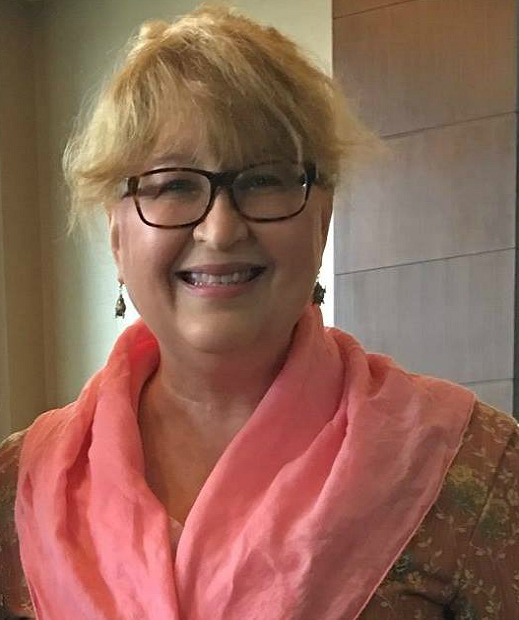
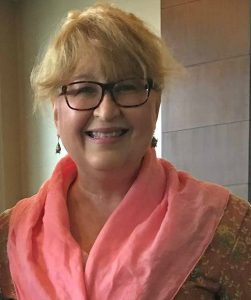 Carrie Fancett Pagels, Ph.D., is the award-winning author of fifteen Christian historical romances, including ECPA bestsellers. Twenty-five years as a psychologist didn’t “cure” her overactive imagination! A self-professed “history geek,” she resides with her family in the Historic Triangle of Virginia but grew up as a “Yooper,” in Michigan’s beautiful Upper Peninsula. Carrie loves to read, bake, bead, and travel – but not all at the same time! You can connect with her at www.CarrieFancettPagels.com.
Carrie Fancett Pagels, Ph.D., is the award-winning author of fifteen Christian historical romances, including ECPA bestsellers. Twenty-five years as a psychologist didn’t “cure” her overactive imagination! A self-professed “history geek,” she resides with her family in the Historic Triangle of Virginia but grew up as a “Yooper,” in Michigan’s beautiful Upper Peninsula. Carrie loves to read, bake, bead, and travel – but not all at the same time! You can connect with her at www.CarrieFancettPagels.com.
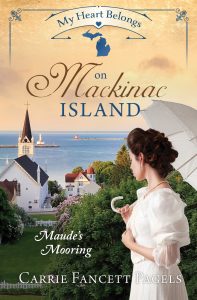 Tell us about your newest book.
Tell us about your newest book.
My latest novel is My Heart Belongs on Mackinac Island: Maude’s Mooring which earned a Romantic Times Book Reviews Top Pick in July, when it released! This story I consider a legacy book for me. It is set on Mackinac Island, which I love, at the turn of the century (in 1895) a time period I really enjoy, and I had the privilege of researching at the Grand Hotel, a gorgeous place! The hardcover releases from Thorndike in October!
My upcoming novella, “Love’s Escape” is in The Captive Brides Collection (Barbour Publishing, October, 2017). This is a freedom story, with my heroine, Letitia, being conducted north on the Underground Railroad. Unfortunately, poor Lettie starts her journey in a coffin!
What genre do you focus on and why?
Christian Historical Romance. I love history, love romance, and love a spiritual story arc in fiction.
Why do you write? What drives you?
I write because God has called me to do so, and I do it to please Him. And, thankfully, He has given me joy for the journey! I was a psychologist for 25 years until my Rheumatoid Arthritis disabled me. I pictured myself writing after retiring when I was maybe 70 or so, but that timeline got moved up when I could no longer work.
Who is your main character, and how did you choose that name?
Maude Welling is named for my grandmother, Maude Carrie Williams Fancett, who was born in 1895 (which is why I picked that year for the story.)
What does a day in your writing world look like?
I have this habit of running laundry while writing – like almost always. I prefer to write outside on our deck. Since I live in Virginia, where I can do this for many months of the year, that’s my favorite place to write, at our picnic table! With my physical impairments, I can only write for short periods of time. So, I’ll write for maybe two half hours sessions in the morning and the same later in the afternoon, maybe three days a week. Any more than that and I’m risking increased pain. I also blog and of course have to respond to writerly things, so I’m on the computer for other things, too, in between and usually on alternate days.
What is the hardest part of being an author? Why?
There are so many authorly things I’d like to do that I’m physically unable to do. But I’ve been trying to work my way around them with God’s help. For instance, two years ago I tried doing a research, book signing, research, and library speaking trip in just over a week and it nearly did me in! So, this past July, I promoted Maude’s Mooring on Mackinac Island and in Northern Michigan and in the Upper Peninsula, but we stayed the whole month so that I could rest between speaking engagements, research, and book signings. That was much more manageable. And I do enjoy traveling for research.
What’s the best part of your author’s life? Why?
I’m a history geek and especially if it involves traveling to my home state of Michigan.
What is the craziest thing you’ve experienced as an author?
Crazy, in an excellent way, was having a planned single book signing at the Island Bookstore morph into three signings and eleven cases of books signed! That was amazing in the extreme!
What are you most proud of?
I’m very pleased with this novel! I thank God for my “Problem Child” manuscript turning out so beautifully in the end!
What is your favorite pastime?
I like to do beadwork. I also enjoy listening to audiobooks. And baking. And visiting cool places.
Do you have other books? We’d love to know.
Yes, I have eleven other books (novels, novellas, short story) in print and another upcoming four releases in collections (all from Barbour). I also have contributed to a nonfiction book and have an award-winning short story in a collection from Family Fiction.
What are you working on now?
I am writing “The Sugarplum Ladies” a novella in A Victorian Christmas collection which will release from Barbour in 2018.
Website: www.CarrieFancettPagels.com
Link to book: Links to purchase My Heart Belongs on Mackinac Island: Maude’s Mooring (Barbour Publishing, July 2017)
Barbour Publishing http://www.barbourbooks.com/product/My-Heart-Belongs-on-Mackinac-Island,14733.aspx?Tab=Books&sj=0
Social media links: Website: www.carriefancettpagels.com
Blogs: Overcoming With God and Colonial Quills
